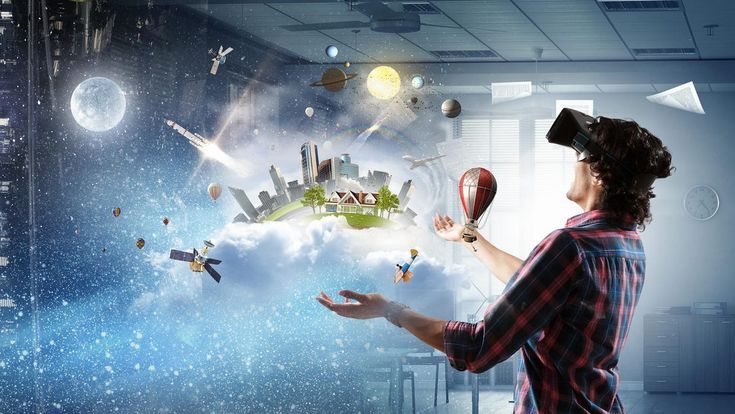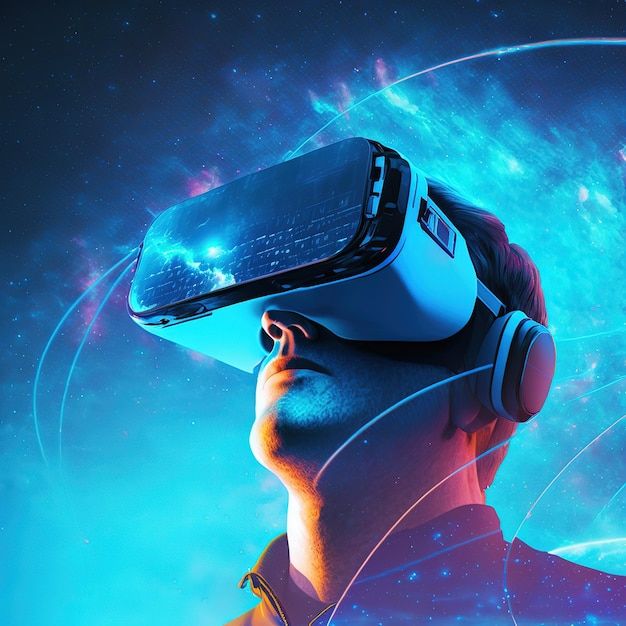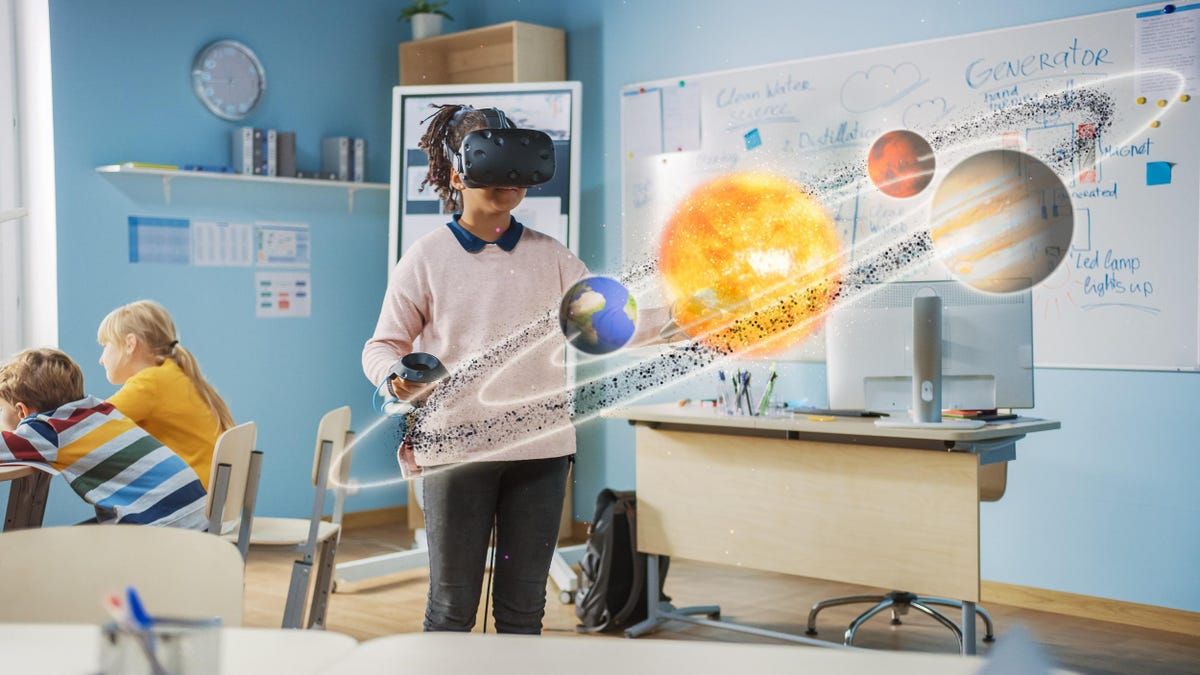The boundaries between our physical world and digital experiences are becoming increasingly permeable, thanks to the rapid advancements in Augmented Reality (AR) and Virtual Reality (VR). These immersive technologies are no longer confined to science fiction or niche gaming communities; they are rapidly reshaping industries, transforming how we work, learn, socialize, and entertain ourselves. AR overlays digital information onto our real-world view, while VR fully immerses us in simulated environments. Together, they are creating a spectrum of mixed realities that promise to revolutionize human-computer interaction, offering unprecedented levels of presence and engagement. This powerful convergence is truly blurring the lines of reality, paving the way for experiences that were once unimaginable.
AR, VR, and MR
To truly grasp the transformative potential, it’s essential to differentiate between the core technologies that constitute the broader immersive reality spectrum.
A. Virtual Reality (VR): Full Immersion
Virtual Reality (VR) creates a completely simulated environment that can be experienced visually and audibly. Users wear headsets that block out the physical world, transporting them entirely into a digital realm.
- Full Sensory Immersion: VR aims to provide a sense of ‘presence’ by engaging users’ senses (primarily sight and sound) to make them feel as if they are truly within the virtual world. Advanced systems can also incorporate haptic feedback for touch.
- Headsets and Controllers: Typical VR setups involve a head-mounted display (HMD) like the Meta Quest, HTC Vive, or PlayStation VR, coupled with hand controllers for interaction within the virtual space.
- Use Cases: Primarily used for highly immersive gaming, realistic training simulations (e.g., flight, medical surgery), virtual tourism, and architectural walkthroughs where a complete digital environment is beneficial.
- Limitations: Can lead to motion sickness for some users, requires dedicated hardware, and isolates the user from their physical surroundings, making it less suitable for tasks requiring real-world awareness.
B. Augmented Reality (AR): Digital Overlay on Reality
Augmented Reality (AR), in contrast to VR, overlays digital information (graphics, sounds, haptic feedback) onto the real world in real-time. It enhances a user’s perception of reality rather than replacing it.
- Real-world Context: AR applications typically use the camera of a smartphone, tablet, or specialized AR glasses to display digital content that appears to exist within the user’s physical environment.
- Less Isolation: Users remain fully aware of their physical surroundings, making AR suitable for tasks that integrate digital information with real-world activities.
- Accessibility: Often accessible via ubiquitous devices like smartphones, lowering the barrier to entry compared to dedicated VR headsets.
- Use Cases: Popular for mobile gaming (e.g., Pokémon Go), navigation overlays, interactive retail experiences, industrial maintenance and repair guides, and educational tools that bring digital content into the classroom.
C. Mixed Reality (MR): Merging Real and Virtual
Mixed Reality (MR) is often considered the next evolution, blurring the lines between AR and VR. It allows for digital objects to interact with the real world in a more profound way, where digital and physical objects co-exist and interact in real-time.
- Interactivity and Co-existence: MR enables digital objects to be ‘anchored’ to physical locations, respond to real-world lighting, and even be obstructed by physical objects. Users can often interact with both digital and physical elements simultaneously.
- Advanced Hardware: Typically requires more sophisticated hardware, often transparent headsets with advanced sensors for spatial mapping (e.g., Microsoft HoloLens, Magic Leap).
- Use Cases: Highly valuable for collaborative design (architects reviewing models together in a physical room), remote assistance where digital instructions are overlaid on physical machinery, and complex training scenarios that combine real and virtual elements.
- The Immersive Continuum: AR, VR, and MR exist on a spectrum. VR is at one end (full virtual), AR is closer to the real world (enhanced reality), and MR sits in between, enabling a true blending of digital and physical realities.
Core Technologies Powering the Immersive Revolution
The rapid advancement of AR and VR is underpinned by significant breakthroughs across multiple technological domains. These innovations are continuously improving the fidelity, accessibility, and utility of immersive experiences.
A. Advanced Display Technologies
The quality and capabilities of screens and optical systems are crucial for convincing immersive experiences.
- High-Resolution Displays: VR headsets now feature displays with resolutions approaching or exceeding 4K per eye, significantly reducing the ‘screen-door effect’ (visible pixels) and improving visual clarity.
- Wide Field of View (FoV): Expanding the FoV in headsets reduces tunnel vision and enhances immersion, making the virtual world feel more natural.
- Micro-OLED and Pancake Optics: Emerging display technologies like Micro-OLED offer higher pixel density and contrast in smaller form factors, while pancake optics enable thinner, lighter headsets by folding light paths.
- Varifocal Displays: Future displays aim to solve the vergence-accommodation conflict (where eyes focus at a fixed distance in VR but objects appear at different depths) by dynamically adjusting focus, reducing eye strain and improving realism.
B. Powerful Processing and Graphics Rendering
Generating realistic virtual environments and seamless AR overlays requires immense computational power.
- Dedicated GPUs: High-performance Graphics Processing Units (GPUs) are essential for rendering complex 3D scenes at high frame rates (e.g., 90-120 frames per second to prevent motion sickness).
- Edge Computing: For AR, processing some data closer to the device (on the edge) reduces latency, which is critical for real-time overlays and interactions.
- Cloud Rendering: For highly complex VR/AR experiences, some rendering can be offloaded to powerful cloud servers, streamed to the device, reducing local hardware requirements.
- Specialized SoCs: Mobile VR/AR devices increasingly use custom Systems-on-Chip (SoCs) optimized for immersive workloads, balancing performance with power efficiency.
C. Precise Tracking and Spatial Mapping
Accurately tracking user movement and mapping the physical environment are fundamental for believable AR/VR/MR.
- Inside-Out Tracking: Many modern VR/AR headsets use integrated cameras to track the user’s position and orientation relative to their environment without external base stations. This simplifies setup and increases mobility.
- Hand and Eye Tracking: Advanced sensors can track the precise movements of a user’s hands (for controller-free interaction) and eyes (for foveated rendering, where only the area a user is looking at is rendered at full resolution).
- Spatial Mapping and Scene Understanding: AR/MR devices use depth sensors (e.g., LiDAR, structured light) and computer vision algorithms to create a real-time 3D map of the physical environment, identifying surfaces, objects, and their dimensions. This allows digital content to accurately interact with the real world.
- Haptic Feedback: Technologies that simulate the sense of touch, adding another layer of immersion (e.g., vibrating controllers, haptic suits).
D. Artificial Intelligence (AI) and Machine Learning (ML)
AI and ML are becoming increasingly integral to enhancing immersive experiences.
- Natural Language Processing (NLP): For voice commands and intelligent virtual assistants within AR/VR.
- Computer Vision: Essential for object recognition, scene understanding, gesture recognition, and facial tracking in AR/VR.
- Generative AI: Creating realistic textures, 3D models, soundscapes, or even entire virtual worlds procedurally, reducing manual development effort.
- Behavioral Prediction: AI can predict user intent or optimize interactions based on past behavior within immersive environments.
E. Network Connectivity (5G and Wi-Fi 6E)
High-bandwidth, low-latency connectivity is crucial for untethered VR and collaborative AR experiences.
- 5G: Provides the necessary speed and minimal latency for streaming complex virtual environments to mobile headsets or facilitating real-time multi-user AR experiences without lag.
- Wi-Fi 6E: Offers dedicated spectrum for high-speed local wireless VR streaming, essential for tethered-like performance without the cables.
Transformative Applications of AR/VR Blurring Reality
The impact of AR and VR extends far beyond entertainment, offering profound transformations across a diverse array of industries and daily activities.
A. Immersive Entertainment and Gaming
Gaming remains a flagship application for VR, offering unparalleled immersion. AR also creates new forms of interactive entertainment.
- Next-Gen Gaming: VR delivers experiences from realistic simulations to fantastical adventures, placing players directly within the game world. AR adds digital elements to physical spaces for games like ‘Pokémon Go’.
- Virtual Concerts and Events: Attending live music concerts, sports events, or art exhibitions in virtual venues, transcending geographical limitations.
- Interactive Storytelling: New forms of narrative experiences where users are active participants in the story, influencing outcomes within a virtual world.
- Social VR Platforms: Creating virtual spaces where people can meet, interact, and build communities, offering a sense of presence akin to being together physically.
B. Revolutionizing Education and Training
AR and VR offer powerful tools for experiential learning, significantly enhancing engagement and retention.
- Immersive Classrooms: Students can virtually explore historical sites, dissect virtual organs, or conduct dangerous chemistry experiments in a safe, simulated environment.
- Skilled Trade Training: VR simulations for learning complex machinery operation, welding, or electrical work, providing hands-on practice without expensive equipment or risk.
- Medical Training and Surgery Simulation: Surgeons can practice complex procedures in highly realistic virtual operating rooms, improving proficiency and reducing errors in real surgeries. AR can overlay patient data directly during real procedures.
- Corporate Training: Onboarding new employees, teaching complex sales pitches, or conducting safety drills in immersive, interactive scenarios.
C. Transforming Industrial Design and Manufacturing
AR and VR are streamlining processes from product conception to maintenance, improving efficiency and reducing costs.
- Collaborative Design Review: Engineers and designers can review 3D models of products or buildings in AR/VR, walking through virtual prototypes, making real-time adjustments, and collaborating from different locations.
- Virtual Prototyping: Drastically reducing the need for expensive physical prototypes by allowing engineers to virtually test and iterate designs.
- Assembly and Maintenance Guidance: AR overlays digital instructions directly onto physical machinery, guiding technicians through complex repair or assembly tasks step-by-step, reducing errors and training time.
- Factory Planning and Optimization: Simulating factory layouts and workflows in VR to identify inefficiencies and optimize production lines before physical implementation.
D. Enhancing Retail and E-commerce Experiences
AR and VR are creating new ways for consumers to interact with products and enhance the shopping experience.
- Virtual Try-On: AR apps allow users to virtually try on clothes, glasses, or makeup using their smartphone camera before purchasing.
- Virtual Furniture Placement: Customers can preview how furniture or appliances would look in their own homes using AR, projected to scale.
- Immersive Showrooms: VR allows customers to explore virtual car dealerships or real estate properties, offering interactive tours and customization options from anywhere.
- Personalized Shopping: AI-powered AR/VR experiences can offer highly personalized product recommendations and interactive guides based on user preferences and physical environment.
E. Redefining Healthcare and Therapy
Beyond medical training, AR and VR are finding applications in patient care, diagnostics, and therapy.
- Pain Management and Therapy: VR experiences can distract patients from pain during medical procedures or serve as therapeutic tools for treating phobias, PTSD, and anxiety disorders through controlled exposure.
- Rehabilitation: AR/VR can create engaging, gamified environments for physical therapy and motor rehabilitation, making exercises more motivating.
- Surgical Planning and Visualization: Surgeons can use VR to plan complex operations based on patient scans, creating a detailed 3D map of the anatomy to practice procedures.
- Mental Health Support: Providing virtual environments for meditation, mindfulness, or social interaction for individuals with mental health challenges.
F. Architectural Visualization and Construction
AR and VR offer powerful tools for visualizing, designing, and even assisting in the construction of buildings.
- Immersive Architectural Walkthroughs: Clients can virtually walk through proposed buildings before construction begins, experiencing spaces and making design changes in real-time.
- On-Site AR Overlays: Construction workers can use AR glasses to overlay BIM (Building Information Modeling) data onto the physical construction site, showing planned placements of pipes, wires, or structural elements, aiding precision and reducing errors.
- Collaborative Design Review: Architects, engineers, and clients can review and annotate 3D models together in an MR environment, making real-time design decisions from disparate locations.
- Remote Inspection and Troubleshooting: Experts can remotely guide on-site personnel through complex inspections or repairs by providing digital annotations and instructions overlaid on their real-world view.

Challenges and Considerations in AR/VR Adoption
Despite their immense promise, the widespread adoption of AR and VR technologies faces several significant hurdles that developers, businesses, and users must collectively address.
A. Hardware Limitations and Accessibility
The current state of AR/VR hardware presents considerable challenges for mass adoption.
- Cost: High-end VR headsets and specialized AR glasses can be prohibitively expensive for the average consumer or small business, limiting market penetration.
- Bulk and Comfort: Many headsets are still bulky, heavy, and can be uncomfortable for extended use, leading to user fatigue and reluctance.
- Form Factor for AR: True everyday AR glasses need to be lightweight, stylish, and offer a wide field of view without being distracting—a significant engineering challenge.
- Computing Power: Untethered VR requires powerful mobile processors that generate heat and drain batteries quickly. Cloud rendering is an option but adds latency and network dependency.
B. Content Development and Ecosystem Maturity
Creating compelling and high-quality AR/VR content is complex, expensive, and requires specialized skills.
- High Production Costs: Developing immersive experiences (especially realistic VR worlds) is resource-intensive, requiring 3D modeling, animation, spatial audio, and complex programming.
- Lack of Standardized Tools: While progress is being made, the development ecosystem is still fragmented, with various SDKs, platforms, and authoring tools, making it harder for developers.
- Limited Killer Apps: Beyond gaming, there’s still a search for truly compelling, widespread ‘killer apps’ that drive mass adoption and demonstrate clear value in everyday life or business workflows.
- Discovery and Distribution: Discovering and distributing AR/VR content can be challenging, as traditional app stores are not always optimized for immersive experiences.
C. User Experience (UX) and Usability
Ensuring a smooth, intuitive, and comfortable user experience remains a critical area for improvement.
- Motion Sickness (Cybersickness): A significant barrier for some VR users, caused by a disconnect between visual motion and vestibular system feedback. While improving, it’s not fully eliminated.
- Intuitive Interaction: Natural and intuitive ways to interact with virtual objects without complex controllers are still evolving. Hand tracking, eye tracking, and brain-computer interfaces are promising but not yet mainstream.
- Onboarding and Learning Curve: New users often face a steep learning curve to navigate and interact effectively within immersive environments.
- Privacy and Data Security: AR/VR devices collect vast amounts of sensitive data (spatial maps of homes/offices, eye movements, biometric data). Ensuring the privacy and security of this data is a paramount concern.
D. Network Latency and Bandwidth Requirements
For many advanced AR/VR/MR applications (e.g., cloud rendering, multi-user collaboration, real-time spatial mapping), low-latency and high-bandwidth network connectivity are non-negotiable.
- 5G Dependency: While 5G promises to address this, its widespread availability and consistent performance are still evolving globally.
- Wi-Fi Reliability: High-speed, low-latency Wi-Fi 6E/7 is crucial for untethered room-scale VR, but network congestion and interference can still impact performance.
E. Ethical and Societal Implications
As immersive technologies become more pervasive, they raise profound ethical and societal questions.
- Digital Divide: Unequal access to expensive hardware and high-speed internet could exacerbate existing societal inequalities.
- Addiction and Mental Health: Concerns about excessive use leading to addiction, social isolation, or negative impacts on mental well-being, similar to concerns with social media.
- Deepfakes and Misinformation: The ability to create highly realistic virtual content could be misused for generating convincing deepfakes or spreading misinformation.
- Identity and Avatars: The psychological impact of living through avatars in virtual worlds, and issues around identity theft or harassment in digital spaces.
- Regulation and Governance: The lack of clear regulatory frameworks for virtual spaces, data collection, and digital ownership.
Addressing these challenges is critical for AR/VR to move from niche applications to widespread, beneficial integration into daily life and industry.
Best Practices for Designing and Deploying Immersive Experiences
For developers and businesses looking to leverage AR/VR effectively, a strategic approach focusing on user experience, technical robustness, and ethical considerations is crucial.
A. Define Clear Use Cases and Value Proposition
Before embarking on an AR/VR project, clearly articulate the specific problem you are solving or the unique value you are creating. Don’t build AR/VR just for the sake of it. Focus on where immersion, spatial context, or presence provides a distinct advantage over traditional interfaces. Start with a minimum viable product (MVP) to test assumptions and gather feedback.
B. Prioritize User Comfort and Accessibility
User experience is paramount. Design immersive experiences that minimize motion sickness (e.g., stable frame rates, comfortable field of view, subtle visual cues for orientation). Offer accessibility options (e.g., adjustable text size, customizable controls, support for various input methods) to cater to a diverse user base. Comfort and intuitive interaction are key to user retention.
C. Optimize for Performance and Resource Management
Immersive experiences are computationally intensive. Optimize your applications for peak performance:
- Efficient 3D Models: Use optimized geometry, textures, and lighting to reduce rendering overhead.
- Asset Streaming: Stream content dynamically rather than loading everything at once.
- LOD (Level of Detail): Implement LOD systems where more detailed models are rendered closer to the user.
- Network Optimization: For multiplayer or cloud-rendered experiences, optimize network traffic and minimize latency.
- Battery Management: For mobile AR/VR, design for power efficiency to maximize usage time.
D. Design for Natural Interaction
Strive for interactions that feel intuitive and natural within the immersive environment.
- Hand Tracking: Leverage controller-free hand tracking where appropriate to allow direct manipulation of virtual objects.
- Eye Tracking: Utilize eye tracking for foveated rendering and to enable gaze-based interactions, reducing the need for explicit pointing.
- Voice Commands: Integrate natural language processing for voice-based interactions to simplify complex menus or commands.
- Spatial Computing Principles: Design digital content to accurately reflect and interact with the physical environment, respecting physics and real-world scale.
E. Develop Robust Content Pipelines and Tools
Invest in robust content creation pipelines and leverage specialized tools to streamline development.
- 3D Content Creation Tools: Master industry-standard 3D modeling and animation software (e.g., Blender, Maya, ZBrush).
- Game Engines: Utilize powerful game engines like Unity or Unreal Engine, which provide comprehensive toolsets for building interactive AR/VR experiences.
- Modular Asset Libraries: Create reusable asset libraries to accelerate development and maintain consistency.
- Version Control: Implement robust version control for all immersive assets and codebases, especially in collaborative environments.
F. Address Privacy and Security Proactively
Given the sensitive nature of data collected by AR/VR devices, proactive privacy and security measures are essential.
- Data Minimization: Only collect the data absolutely necessary for the application’s function.
- Transparency: Clearly communicate to users what data is being collected, why, and how it will be used.
- Encryption: Encrypt sensitive data at rest and in transit.
- Access Controls: Implement strict access controls for spatial maps and user data.
- Regular Audits: Conduct regular security audits and penetration testing on AR/VR applications and platforms.
G. Consider Multi-User and Collaborative Experiences
Many of the most compelling use cases for AR/VR involve collaboration. Design with multi-user capabilities in mind:
- Shared Spaces: Enable multiple users to interact within the same virtual or augmented environment.
- Avatar Representation: Provide customizable avatars for user identity in shared virtual spaces.
- Real-time Synchronization: Ensure low-latency synchronization of user actions and object states across all participants.
- Spatial Audio: Implement spatial audio cues to enhance the sense of presence and allow users to intuitively locate others in the virtual space.
H. Plan for Iteration and Evolution
The AR/VR landscape is rapidly evolving. Design your solutions to be flexible and adaptable.
- Modular Architecture: Use a modular approach that allows for easy updates, new feature integration, and adaptation to new hardware generations.
- User Feedback Loops: Continuously gather user feedback and iterate on the experience, optimizing based on real-world usage.
- Stay Abreast of Trends: Monitor new hardware, software, and research breakthroughs to incorporate cutting-edge capabilities.
The Future Trajectory: Reality’s New Frontier
The journey of AR and VR is just beginning, and the future promises even more profound integrations and capabilities that will fundamentally redefine our relationship with digital information and each other.
A. Ubiquitous AR and Contextual Computing
The long-term vision is for ubiquitous AR, where smart glasses become as commonplace as smartphones, seamlessly overlaying digital information onto our daily lives without being obtrusive. This will enable:
- Contextual Information: Digital information automatically appearing based on your location, what you’re looking at, or who you’re speaking with.
- Personalized Experiences: AR tailoring advertisements, recommendations, or assistance directly to your real-world view based on your preferences.
- Everyday Utility: AR becoming an invisible layer of digital assistance for navigation, translation, shopping, and learning.
B. The Spatial Internet (Metaverse Evolution)
The concept of the Spatial Internet (or a truly interoperable metaverse) will mature, moving beyond isolated virtual worlds.
- Persistent Digital Layers: Digital content in AR will become persistent and shared across users and devices, allowing digital objects to ‘exist’ in specific physical locations for everyone to see and interact with.
- Interoperable Avatars and Assets: Users will have consistent digital identities and assets that can seamlessly move between different virtual worlds and AR experiences.
- New Economic Models: Digital economies within these persistent virtual spaces, driven by NFTs, cryptocurrencies, and new forms of digital commerce and ownership.
C. Neural Interfaces and Direct Brain-Computer Interaction
Beyond controllers and gestures, the ultimate blurring of reality lines could come from neural interfaces and direct brain-computer interaction (BCI).
- Thought-Controlled AR/VR: Controlling immersive experiences directly with thoughts, movements, or even emotions, eliminating the need for physical input devices.
- Enhanced Sensory Input: BCIs could potentially enable direct digital input to the brain, enhancing existing senses or even creating new ones within immersive environments.
- Therapeutic Applications: Advanced BCIs for treating neurological disorders, restoring senses, or enhancing cognitive functions within immersive settings.
D. Hyper-Personalization and Adaptive Experiences
AI will drive hyper-personalization, creating immersive experiences that constantly adapt to the individual user’s preferences, emotional state, and learning style.
- AI Companions: Virtual assistants and AI characters within AR/VR that feel more lifelike and responsive.
- Dynamic Content Generation: AI generating real-time content (e.g., unique NPCs, adaptive storylines, personalized environments) within immersive worlds based on user interaction.
- Adaptive Learning: Educational AR/VR experiences that adjust difficulty and teaching methods dynamically based on a student’s performance and learning pace.
E. Ethical AI and Responsible Design Frameworks
As immersive technologies become more powerful and pervasive, the importance of ethical AI and responsible design frameworks will be paramount.
- Privacy by Design: Building privacy safeguards directly into the core architecture of AR/VR systems.
- Bias Mitigation: Actively working to prevent algorithmic bias in AI-driven immersive content and interactions.
- Digital Well-being: Designing experiences that promote healthy usage patterns and mitigate potential negative impacts on mental health and social interaction.
- Governance and Regulation: Developing clear legal and ethical guidelines for data collection, digital identity, safety, and content moderation in the immersive spaces.
Conclusion
Augmented Reality and Virtual Reality are not merely technological novelties; they are transformative forces that are rapidly blurring the lines between our physical existence and digital interaction. By offering unparalleled levels of immersion, presence, and contextual information, these technologies are redefining how we connect, create, learn, and engage with the world around us. From revolutionizing industrial processes and healthcare to fundamentally changing entertainment and social interaction, the impact is pervasive and profound.
While challenges remain in terms of hardware accessibility, content development, and ethical considerations, the relentless pace of innovation suggests that these hurdles will continue to be overcome. As AR and VR evolve towards more seamless integration, intuitive interfaces, and ubiquitous presence, they promise to unlock a future where digital information is not just viewed on a screen but experienced as an integral part of our reality. The journey has begun, and the destination is a world where the boundaries of perception are continuously expanded, making the previously impossible, vividly real.









